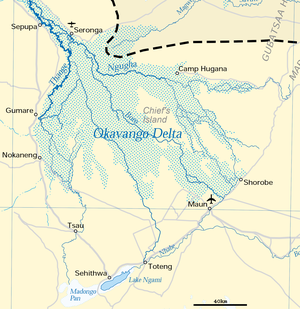Okavango Alluvial Fan
| Okavango Delta | |
|---|---|
| Name as inscribed on the World Heritage List | |

Map of the delta with basin boundary as dotted line
|
|
| Type | Natural |
| Criteria | vii, ix, x |
| Reference | 1432 |
| UNESCO region | Africa |
| Inscription history | |
| Inscription | 2014 (38th Session) |
The Okavango Delta (or Okavango Grassland) (formerly spelled Okovango or Okovanggo) in Botswana is a very large, swampy inland delta formed where the Okavango River reaches a tectonic trough in the central part of the endorheic basin of the Kalahari. All the water reaching the Delta is ultimately evaporated and transpired, and does not flow into any sea or ocean. Each year approximately 11 cubic kilometers of water spreads over the 6,000-15,000 km2 area. Some flood-waters drain into Lake Ngami. The Moremi Game Reserve, a National Park, is on the eastern side of the Delta. The scale and magnificence of the Okavango Delta helped it secure a position as one of the Seven Natural Wonders of Africa, which were officially declared on February 11, 2013 in Arusha, Tanzania. On 22 June 2014, the Okavango Delta became the 1000th site to be officially inscribed on the UNESCO World Heritage List.
The area was once part of Lake Makgadikgadi, an ancient lake that mostly dried up by the early Holocene. Although the Okavango Delta is widely believed to be the world's largest inland delta, it is not. In Africa alone there are two larger similar geological features: the Sudd on the Nile in South Sudan, and the Inner Niger Delta in Mali.
The Okavango is produced by seasonal flooding. The Okavango River drains the summer (January–February) rainfall from the Angola highlands and the surge flows 1,200 kilometres in approximately one month. The waters then spread over the 250 km by 150 km area of the delta over the next four months (March–June). The high temperature of the delta causes rapid transpiration and evaporation, resulting in a cycle of rising and falling water level that was not fully understood until the early 20th century. The flood peaks between June and August, during Botswana’s dry winter months, when the delta swells to three times its permanent size, attracting animals from kilometres around and creating one of Africa’s greatest concentrations of wildlife.
...
Wikipedia
